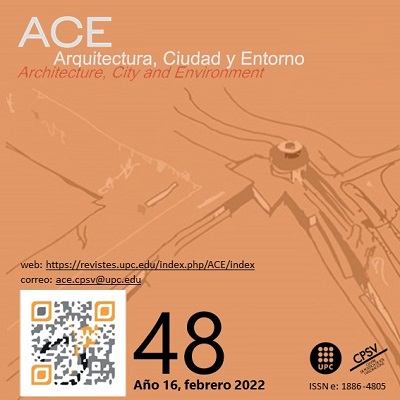Design of Subsidized OSH’s Housing Estates in Post-War Spain. The case of Zaragoza (1954-1964)
DOI:
https://doi.org/10.5821/ace.16.48.9526Keywords:
Social Housing, Franco’s Regime, Spanish architecture, ZaragozaAbstract
This paper presents the analysis of the design of dwellings in ten housing estates built by the House Building Union (Obra Sindical del Hogar, OSH) in the city of Zaragoza between 1954 and 1964. All of them were designed by the Spanish architects Alejandro Allanegui and Fausto García Marco. The first part of the text explains the Franco Regime’s regulation on housing subsidies and how it promoted the construction of dwellings of three or more bedrooms. It provides data on the number of dwellings built in the city of Zaragoza, which allows an understanding of the relevance this housing had for the urban growth of the city. Therefore, it presents the urban planning of these housing estates and how their peripheral location exacerbated the social differentiation of the poor families who were intended to live there. The second part of this research analyses the dwellings’ designs, their standardisation and variations, combining the reproduction of the original plans and drawing of the projects and original diagrams. The article discusses how the technical and building improvements of the later housing estates did not affect the interior organisation of the dwellings, which is presented because of the standardisation process created.
Published
Issue
Section
License
| INTELECTUAL PROTECTION CRITERIA |
At this moment, it is count with the "Oficina Española de Patentes y Marcas", while global protection it is being processed by the World Intelectual Property Organization (OMPI/WIPO). Nevertheless the International Standard Serial Number Office (ISSN) has given the following numbers ISSN: 1886-4805 (electronic version) and 1887-7052 (paper version). All articles will be peer reviewed, using double blind reviewing. |
| COPYRIGHT |
The article contents and their comments are authors exclusive liability, and do not reflect necessarily the journal editor commitee's opinion. All ACE published works are subject to the following licence CC BY-NC-ND 3.0 ES http://creativecommons.org/licenses/by-nc-nd/3.0/es/ It implies that authors do not hold nor retain the copyright without restrictions but only those included in the licence. |





































